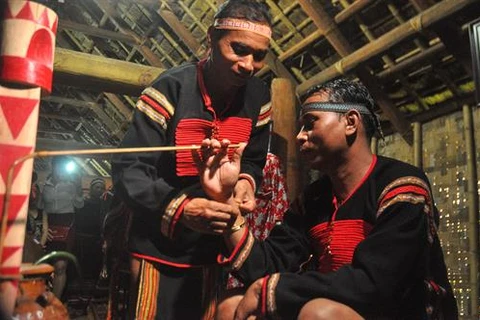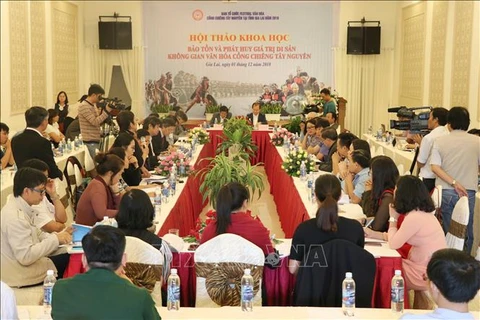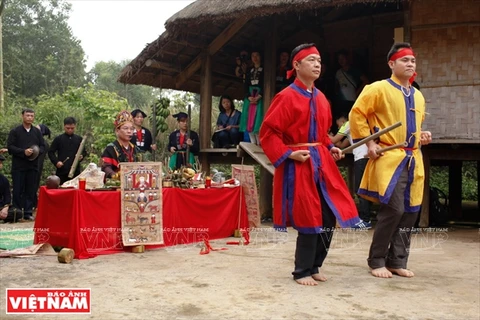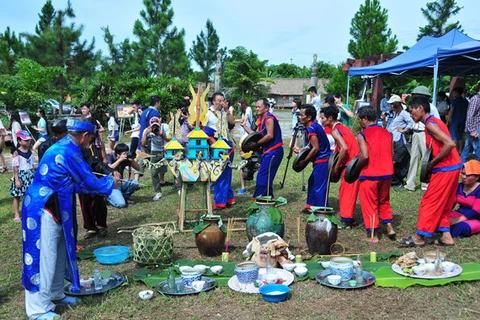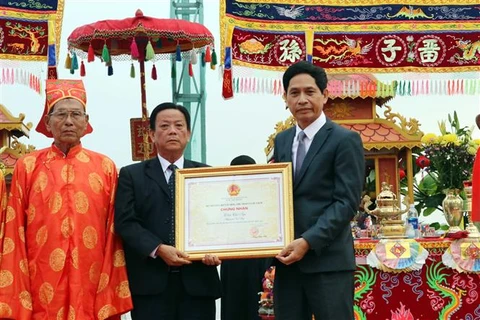 The Trieu Khuc village's festival takes place on the 9th-12th days of the first lunar month. (Photo: VietnamPlus)
The Trieu Khuc village's festival takes place on the 9th-12th days of the first lunar month. (Photo: VietnamPlus)
Hanoi (VNA) – The capital city of Hanoi has had two more cultural icons added to the list of national intangible cultural heritages, namely Trieu Khuc village’s festival and “com” (young sticky rice flakes) production in Me Tri district.
The Ministry of Culture, Sports and Tourism recently issued Decision No.446/QD-BVHTTDL, bestowing national intangible cultural heritage status on the two cultural items.
Trieu Khuc village’s festival- a unique cultural feature
Trieu Khuc village has two communal houses, constructed in the 17th century to worship Bo Cai Dai Vuong Phung Hung. Legend has that Phung Hung chose Trieu Khuc as his headquarters when he and his troops moved to lay siege to Tong Binh citadel (now Hanoi city), helping smash the domination of China’s Tang dynasty.
Annually on the 9th-12th days of the first lunar month, villagers in Trieu Khuc village, Thanh Xuan district hold a festival with traditional rites and cultural activities to commemorate King Phung Hung, who is considered their patron saint as he launched an uprising against northern invaders.
The festival begins with the possession of King Phung Hung’s imperial mantle from Sac temple to Dai Dinh communal house. Various folk games are held during the festival such as lion dance, cock-fighting and wrestling, all cultural identities of the Red River Delta.
 Villagers in Trieu Khuc village, Thanh Xuan district, hold a festival with traditional rites and cultural activities.
Villagers in Trieu Khuc village, Thanh Xuan district, hold a festival with traditional rites and cultural activities.(Photo: VNA)
 The festival begins with the possession of King Phung Hung’s imperial mantle from Sac temple to Dai Dinh communal house.(Photo: VNA)
The festival begins with the possession of King Phung Hung’s imperial mantle from Sac temple to Dai Dinh communal house.(Photo: VNA) A highlight of the festival is the village’s hallmark “Con di danh bong” dance, in which local young men are dressed and made up like girls and dance like girls. It is also among 10 ancient dances honoured at the 1,000th anniversary of Thang Long-Hanoi.
“Com” making in Me Tri district- a Hanoi staple
The capital city of Hanoi has two renowned “com” making villages: Vong in Cau Giay district and nearby Me Tri in Nam Tu Liem district.
 A resident of Me Tri village says the whole family has to rush off their feet during the season for “com”. The “com” making begins at 4 a.m and lasts until 10 p.m.(Photo: Vietnam Pictorial)
A resident of Me Tri village says the whole family has to rush off their feet during the season for “com”. The “com” making begins at 4 a.m and lasts until 10 p.m.(Photo: Vietnam Pictorial)
Over the years, Me Tri “com” making village has witnessed several changes. “Com” is now available year-round, unlike previous years when locals only made “com” in autumn.
Besides, machines have been used during the making of “com”, helping reduce labour and production costs while ensuring the special taste of “com”, which is elegant and fresh.
In addition to these heritages, 15 others were added to the list. They are in the forms of traditional art performance, traditional handicraft, traditional festivals, social practices and beliefs, and folk knowledge.
Below is the list of the 17 heritages:
1. “Luon coi” traditional singing of the Tay ethnic minority group in Pac Nam district, the northern mountainous province of Bac Can
2. The forging craft of the Nung An ethnic minorities in Phuc Sen commune, Quang Uyen district, the northern mountainous province of Cao Bang
3. Can Tho singing in Thoi Lai district, O Mon district, Cai Rang distict, the Mekong Delta city of Can Tho
4. “Men Loong Phat Ai”- cockscomb Tet festival of the Cong ethnic group in Dien Bien district’s Pa Thom commune, Muong Nhe district’s Nam Ke commune and Nam Po district’s Pa Tan commune, the northern mountainous province of Dien Bien
5. “Ga Ma Thu”- a traditional worshipping ritual of the Ha Nhi ethnic minorities in Sin Thau, Chung Chai, Sen Thuong and Leng Su Sin in Muong Nhe district, the northern mountainous province of Dien Bien
6. Ba Danh Pagoda Festival in Ngoc Son commune, Kim Bang district, the northern province of Ha Nam
7. Quyen Son “dam” singing in Thi Son commune, Kim Bang district, the northern province of Ha Nam
8. Trieu Khuc village’s festival in Tan Trieu commune, Thanh Tri district, Hanoi
9. “Com” making of Me Tri ward, Nam Tu Liem district, Hanoi
10. “Mo Tham That” ritual of the Tay ethnic minorities in Lang Giang commune, Van Ban district, the northern mountainous province of Lao Cai
11. “Then” ritual of the Giay ethnic minority in Bat Xat district, the northern mountainous province of Lao Cai
12. “Cap sac” (maturity ritual) of the Dao Quat Chet ethnic minority in Xuan Thuy commune, Yen Lap district, the northern midland province of Phu Tho
13. Traditional brocade weaving of the Hre ethnic people in Ba Thanh commune, Ba To district, the central province of Quang Ngai
14. Robam dance of the Khmer people in Tai Van commune, Tran De district, the Mekong Delta province of Soc Trang
15. Nghinh Ong (Whale Worship) festival in Tran De township, Tran De district, the Mekong Delta province of Soc Trang
16. Patterns on traditional clothes of the Red Dao ethnic group in Son Duong district, Ham Yen district, Chiem Hoa district, Na Hang district and Lam Binh district, the northern mountainous province of Tuyen Quang.
17. “Xuong” singing of the Muong people in Cao Ngoc commune, Thach Lap commune, and Minh Son commune, Ngoc Lac district, the north central province of Thanh Hoa.
According to the Ministry of Culture, Sports and Tourism’s Department of Culture Heritage, Vietnam boasts 288 national intangible heritages.
To become a national intangible cultural heritage, a cultural item must feature identity of a community, reflect cultural diversity and human creativity, be inherited through generations, be able to recover, and receive community approval and commitment for preservation.-VNA









